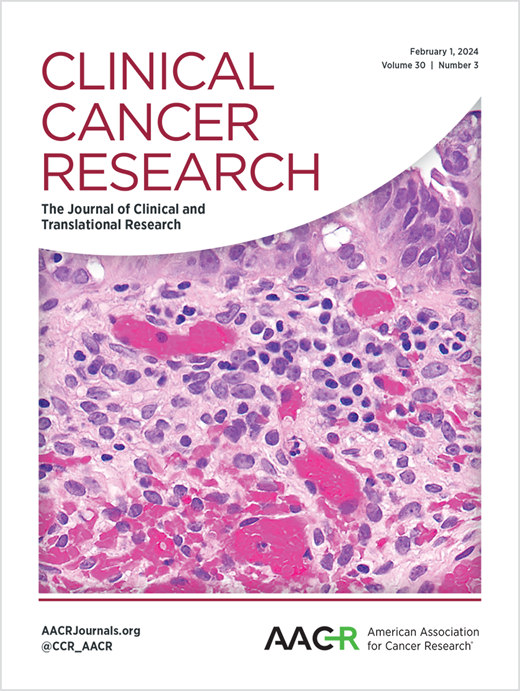Efficacy, Safety, and Influence on Tumor Microenvironment of Neoadjuvant Pembrolizumab plus Ramucirumab for PD-L1 Positive NSCLC: A Phase 2 Trial (EAST ENERGY)
IF 10
1区 医学
Q1 ONCOLOGY
引用次数: 0
Abstract
Purpose: Angiogenesis inhibitors are known to modify tumor immunity. Combination of angiogenesis inhibitors with immune checkpoint inhibitors (ICIs) has shown efficacy against many types of cancers, including non-small cell lung cancer (NSCLC). We investigated the feasibility of neoadjuvant therapy with pembrolizumab and ramucirumab, a vascular endothelial growth factor (VEGF) receptor-2 antagonist for patients with PD-L1-positive NSCLC and its influence on the tumor microenvironment (TME). Patients and Methods: Patients with pathologically proven NSCLC with PD-L1-positive, clinical stage IB-IIIA were eligible. Patients received two cycles of pembrolizumab (200 mg/body) and ramucirumab (10 mg/kg) every three weeks. Surgery was scheduled 4 to 8 weeks after the last dose. The primary endpoint was the major pathologic response (MPR) rate by a blinded independent pathology review. The sample size was 24 patients. Exploratory endpoints were evaluated to elucidate the effects of neoadjuvant therapy on TME. Results: The 24 eligible patients were enrolled between July 2019 and April 2022. The MPR rate was 50.0% (90% confidence interval, 31.9-68.1%). Six patients showed pathological complete response. Grade 3 adverse events (AEs) occurred in 9 patients (37.5%), including 3 immune-related AEs (acute tubulointerstitial nephritis in 2 cases and polymyalgia rheumatica in one). There were no grade 4 or 5 AEs. The transcriptome and multiplexed immunohistochemistry results suggested that tumors with greater CD8+ T-cell infiltration and higher expression of effector molecules at the baseline could show better sensitivity to treatment. Conclusions:This new neoadjuvant combination of pembrolizumab plus ramucirumab was feasible and anti-VEGF agents may enhance the effects of ICIs.新辅助 Pembrolizumab 加 Ramucirumab 治疗 PD-L1 阳性 NSCLC 的疗效、安全性及其对肿瘤微环境的影响:2期试验(EAST ENERGY)
目的:已知血管生成抑制剂可改变肿瘤免疫。血管生成抑制剂与免疫检查点抑制剂(ICIs)联用已显示出对包括非小细胞肺癌(NSCLC)在内的多种类型癌症的疗效。我们研究了PD-L1阳性NSCLC患者使用pembrolizumab和血管内皮生长因子(VEGF)受体-2拮抗剂ramucirumab进行新辅助治疗的可行性及其对肿瘤微环境(TME)的影响。患者和方法:病理证实为PD-L1阳性、临床分期为IB-IIIA的NSCLC患者。患者每三周接受两个周期的 pembrolizumab(200 毫克/体)和 ramucirumab(10 毫克/千克)治疗。手术安排在最后一次给药后4至8周。主要终点是由盲法独立病理审查得出的主要病理反应(MPR)率。样本量为 24 例患者。对探索性终点进行了评估,以阐明新辅助治疗对TME的影响。结果:24名符合条件的患者于2019年7月至2022年4月期间入组。MPR率为50.0%(90%置信区间,31.9-68.1%)。6名患者出现病理完全反应。9名患者(37.5%)发生了3级不良事件(AEs),包括3例免疫相关不良事件(2例急性肾小管间质性肾炎和1例多发性风湿痛)。没有出现 4 级或 5 级 AE。转录组和多重免疫组化结果表明,基线CD8+ T细胞浸润较多、效应分子表达较高的肿瘤对治疗的敏感性更高。结论:pembrolizumab加ramucirumab的新辅助治疗组合是可行的,抗血管内皮生长因子药物可能会增强ICIs的效果。
本文章由计算机程序翻译,如有差异,请以英文原文为准。
求助全文
约1分钟内获得全文
求助全文
来源期刊

Clinical Cancer Research
医学-肿瘤学
CiteScore
20.10
自引率
1.70%
发文量
1207
审稿时长
2.1 months
期刊介绍:
Clinical Cancer Research is a journal focusing on groundbreaking research in cancer, specifically in the areas where the laboratory and the clinic intersect. Our primary interest lies in clinical trials that investigate novel treatments, accompanied by research on pharmacology, molecular alterations, and biomarkers that can predict response or resistance to these treatments. Furthermore, we prioritize laboratory and animal studies that explore new drugs and targeted agents with the potential to advance to clinical trials. We also encourage research on targetable mechanisms of cancer development, progression, and metastasis.
 求助内容:
求助内容: 应助结果提醒方式:
应助结果提醒方式:


